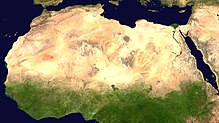Desert greening

Desert greening consists of any of a number of methods used to revitalize deserts. So far only arid and semi-arid desert are meant when using the expression. The icy-deserts and others are considered unsuitable.
Methods
- Landscaping methods to reduce evaporation, erosion, consolidation of topsoil, sandstorms, temperature and more
- Permaculture in general - growing of plant communities Polyculture, composting or multi trophic agriculture
- Planting trees (Pioneer species) and salt-loving plants such as Salicornia and Halophytes
- Regeneration of salty, polluted, or degenerated soils [1]
- Floodwater retention and infiltration (Flood control)[2]
- Greenhouse agriculture like the Integrated biotectural system[3]
- Seawater farming like done by the Seawater foundation[4]
- Inland Mariculture
- Prevention of overgrazing and firewood use
- Training of local residents to care for plantings, water systems etc.
Water
Desert greening is more or less a function of water availability. If sufficient water for irrigation is at hand any hot, cold, sandy or rocky desert can be greened. Water can be made available through saving, reuse, rainwater harvesting, desalination, or direct use of seawater for salt-loving plants. These different paths have unique features, ie: conserving water is a cheap solution. Reuse of treated water and the closing of cycles is the most efficient because closed cycles stand for unlimited and sustainable supply - rainwater management is a decentralized solution and applicable for inland areas [2] - desalination is very secure as long as the primary energy for the operation of the desalination plant is available - Direct use of seawater for seawater agriculture is the most potent, only limited by the need for pumping up the water from sea-level.
Desalination is for example done in project like the Sahara Forest project. This project uses solar stills for the generation of the freshwater.
There are theoretical water sources, too. Like the generation of artificial rain through cloud seeding of various kinds. An available technology called "atmospheric water generation" or air to water is used by the military and is available as micro-solution for drinking water fountains. But this technology uses 200 times more energy than modern desalination plants and cannot be considered for desert-greening.
Once the (fresh or sea)water has been attained, it needs to be distributed. This can be done using dug canals or in some instances aquaducts (which are both the least attractive option since they allow much water to be evaporated), troughs (as used in the Keita Project[5]), earthenware piping (semi-open or closed) or even underground systems ie Qanat.
Depending on the method of distrubution of the water, it can then be provided on different methods to the plants. A costly solution (used only on pipes) is drip irrigation. Other methods are the use of wadis (basically V-shaped ponds dug in the earth)[6] or by simply planting the trees in holes inside/over the water pipe itself. The tree's roots can then suck the water straight from the water pipe (used in Qanat, hydroponics, ...) A similar technique can be done with semi-open pipes (ie dug throughs in the Keita Project).
The use of water is, however, not always without problems. Desert greening by the Helmand and Arghandab Valley Authority irrigation scheme in Afghanistan significantly reduced the water flowing from the Helmand River into Lake Hamun and this, together with drought, was cited as a key reason for the severe damage to the ecology of Lake Hamun, much of which has degenerated since 1999 from a wetland of international importance into salt flats.[7]
Countering desertification
The soil of the Thar Desert in India remains dry for much of the year and is prone to wind erosion. High velocity winds blow soil from the desert, depositing some on neighboring fertile lands, and causing shifting sand dunes within the desert, which buries fences and block roads and railway tracks. Permanent solution to this problem of shifting sand dunes can be provided by planting appropriate species on the dunes to prevent further shifting and planting windbreaks and shelterbelts. These solutions also provide protection from hot or cold and desiccating winds and the invasion of sand. The Rajasthan Canal system is the major irrigation scheme of the Thar Desert and is intended to reclaim it and to check spreading of the desert to fertile areas.
Prevention of shifting sand dunes is accomplished through plantations of Acacia tortilis near Laxmangarh town. There are few local tree species suitable for planting in the desert region and these are slow growing. The introduction of exotic tree species in the desert for plantation has become necessary. Many species of Eucalyptus, Acacia, Cassia and other genera from Israel, Australia, US, Russia, Zimbabwe, Chile, Peru, and Sudan have been tried in the Thar Desert. Acacia tortilis has proved to be the most promising species for desert greening and. The jojoba is another promising species of economic value which has been found suitable for planting in these areas.
See also
- Desertification
- Thar Desert
- Arid Lands Information Network
- Aridification
- Deforestation
- Ecological engineering
- Global warming
- Oasification
- United Nations Convention to Combat Desertification
- Water crisis
References
- ^ Ground Perforation, by Nicol-André Berdellé, August.2011
- ^ a b Recharging dry wells, by Nicol-André Berdellé, May.2011
- ^ Out of the box, by Nicol-André Berdellé, March.2011
- ^ Rethinking Landscapes, by Nicol-André Berdellé, July.2011
- ^ Keita Project
- ^ De Vloei eco-neighbourhood
- ^ Weier, John (3 December 2002), From Wetland to Wasteland; Destructuion of the Hamoun Oasis, NASA Earth Observatory, retrieved 11 May 2012
{{citation}}: External link in|publisher=
External links
- http://permaculture.org.au/
- http://www.greeningthedesert.com/
- http://permaculture.org.au/2009/12/11/greening-the-desert-ii-final/
- http://www.desert-greening.com
- http://www.prototype-creation.de
